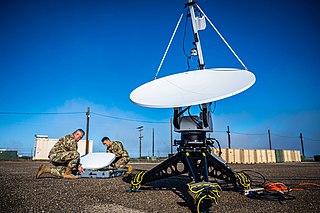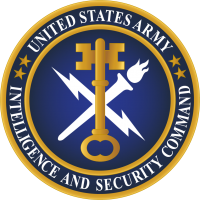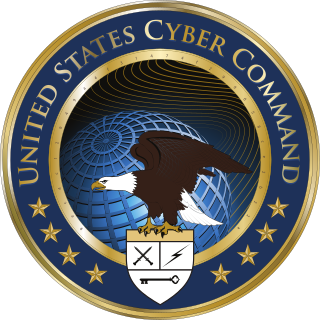Related Research Articles

Electromagnetic warfare or electronic warfare (EW) is warfare involving the use of the electromagnetic spectrum or directed energy to control the spectrum, attack an enemy, or impede enemy operations. The purpose of electromagnetic warfare is to deny the opponent the advantage of—and ensure friendly unimpeded access to—the EM spectrum. Electromagnetic warfare can be applied from air, sea, land, or space by crewed and uncrewed systems, and can target communication, radar, or other military and civilian assets.
Information warfare (IW) is the battlespace use and management of information and communication technology (ICT) in pursuit of a competitive advantage over an opponent. It is different from cyberwarfare that attacks computers, software, and command control systems. Information warfare is the manipulation of information trusted by a target without the target's awareness so that the target will make decisions against their interest but in the interest of the one conducting information warfare. As a result, it is not clear when information warfare begins, ends, and how strong or destructive it is.
A restricted line officer is a designator given to a United States Navy and Navy Reserve line officer who is not eligible for Command at Sea. There are many different types and communities, including Engineering Duty Officers, Aerospace Engineering Duty Officers, Aerospace Maintenance Duty Officers, Naval Intelligence Officers, Cryptologic Warfare Officers, Information Operations Officers, Foreign Area Officers, Public Affairs Officers, Naval Oceanographers, Information Professionals, and Human Resources.

NetOps is defined as the operational framework consisting of three essential tasks, Situational Awareness (SA), and Command & Control (C2) that the Commander (CDR) of US Strategic Command (USSTRATCOM), in coordination with DoD and Global NetOps Community, employs to operate, manage and defend the Global Information Grid (GIG) to ensure information superiority for the United States.
Joint Task Force-Global Network Operations (JTF-GNO) was a subordinate command of United States Strategic Command whose mission was to: direct the operation and defense of the Global Information Grid (GIG) across strategic, operational, and tactical boundaries in support of the US Department of Defense's full spectrum of war fighting, intelligence, and business operations.

Cyberwarfare is the use of cyber attacks against an enemy state, causing comparable harm to actual warfare and/or disrupting vital computer systems. Some intended outcomes could be espionage, sabotage, propaganda, manipulation or economic warfare.

Command and control is a "set of organizational and technical attributes and processes ... [that] employs human, physical, and information resources to solve problems and accomplish missions" to achieve the goals of an organization or enterprise, according to a 2015 definition by military scientists Marius Vassiliou, David S. Alberts, and Jonathan R. Agre. The term often refers to a military system.

The United States Army Intelligence and Security Command (INSCOM) is a direct reporting unit that conducts intelligence, security, and information operations for United States Army commanders, partners in the Intelligence Community, and national decision-makers. INSCOM is headquartered at Fort Belvoir, Virginia.

The 1st Information Operations Command (Land), formerly the Land Information Warfare Activity Information Dominance Center (LIWA/IDC), is an information operations unit under the operational control of U.S. Army Cyber Command (ARCYBER) and headquartered at Fort Belvoir, Virginia.

United States Cyber Command (USCYBERCOM) is one of the eleven unified combatant commands of the United States Department of Defense (DoD). It unifies the direction of cyberspace operations, strengthens DoD cyberspace capabilities, and integrates and bolsters DoD's cyber expertise which focus on securing cyberspace.

The Fleet Electronic Warfare Center (FEWC) is a subordinate organization of the Naval Network Warfare Command (NNWC), which was established in 2008 to be the center for US Navy fleet electronic warfare (EW) operational and tactical issues. It is currently located at Navy Information Dominance Forces (NIDF) Headquarters, in Suffolk, VA as an independent directorate.
Cyberwarfare is the use of computer technology to disrupt the activities of a state or organization, especially the deliberate attacking of information systems for strategic or military purposes. As a major developed economy, the United States is highly dependent on the Internet and therefore greatly exposed to cyber attacks. At the same time, the United States has substantial capabilities in both defense and offensive power projection thanks to comparatively advanced technology and a large military budget. Cyberwarfare presents a growing threat to physical systems and infrastructures that are linked to the internet. Malicious hacking from domestic or foreign enemies remains a constant threat to the United States. In response to these growing threats, the United States has developed significant cyber capabilities.

The U.S. Marine Corps Forces Cyberspace Command is a functional formation of the United States Marine Corps to protect critical infrastructure from cyberattack. Marine Corps Forces Cyberspace Command is the Marine Corps component to U.S. Cyber Command. It comprises a command element, the Marine Corps Cyber Operations Group, and the Marine Corps Cyber Warfare Group, a total of approximately 800 personnel. MARFORCYBER was established on January 21, 2010 under the command of LtGen George J. Flynn,. As of 22 March 2024, MajGen Joseph Matos is in command.
Information Operations is a category of direct and indirect support operations for the United States Military. By definition in Joint Publication 3-13, "IO are described as the integrated employment of electronic warfare (EW), computer network operations (CNO), psychological operations (PSYOP), military deception (MILDEC), and operations security (OPSEC), in concert with specified supporting and related capabilities, to Information Operations (IO) are actions taken to affect adversary information and information systems while defending one's own information and information systems.

Counter-IED efforts are done primarily by military and law enforcement with the assistance of the diplomatic and financial communities. It involves a comprehensive approach of countering the threat networks that employ improvised explosive devices (IEDs), defeating the devices themselves, and training others. Counter-IED, or C-IED, is usually part of a broader counter-terrorism, counter-insurgency, or law enforcement effort. Because IEDs are a subset of a number of forms of asymmetric warfare used by insurgents and terrorists, C-IED activities are principally against adversaries and not only against IEDs. C-IED treats the IED as a systemic problem and aims to defeat the IED threat networks themselves.

Sentry Eagle, the National Initiative Protection Program, is a compartmented program of the National Security Agency's (NSA) Central Security Service (CSS) and the US Strategic Command Joint Functional Component Command - Network Warfare (JFCC-NW). Its existence was revealed during the 2013 global surveillance disclosure by Edward Snowden.
The Fourth Department (4PLA) of the Chinese People's Liberation Army General Staff Department (GSD) is also known as the Electronic Countermeasures and Radar Department. It was charged with the Chinese People's Liberation Army's offensive electronic warfare (EW) and information warfare (IW) missions, to include offensive cyber operations. In 2016, its functions were transferred to the Network Systems Department of the PLA Strategic Support Force.

The 151st Theater Information Operations Group, or 151st TIOG, is an Information Operations formation of the United States Army Reserve, headquartered at Fort Totten, New York. Founded in 2009, the 151st TIOG is the only Theater Information Operations Group in the U.S. Army Reserve. It is composed mostly of Army Reserve Soldiers in two battalions based out of Parks Reserve Forces Training Area, Fort George G. Meade, and Fort Totten. The current commander is Colonel Jonathan Steinbach, who assumed command in July 2023.
The Internet of Military Things (IoMT) is a class of Internet of things for combat operations and warfare. It is a complex network of interconnected entities, or "things", in the military domain that continually communicate with each other to coordinate, learn, and interact with the physical environment to accomplish a broad range of activities in a more efficient and informed manner. The concept of IoMT is largely driven by the idea that future military battles will be dominated by machine intelligence and cyber warfare and will likely take place in urban environments. By creating a miniature ecosystem of smart technology capable of distilling sensory information and autonomously governing multiple tasks at once, the IoMT is conceptually designed to offload much of the physical and mental burden that warfighters encounter in a combat setting.
The Third Department (3PLA) of the People's Liberation Army Joint Staff Department was responsible for China's military computer network operations (CNO) and signals intelligence (SIGINT) operations. It has been compared to the United States' National Security Agency or British GCHQ. In 2016, its functions were transferred to the Network Systems Department of the PLA Strategic Support Force.